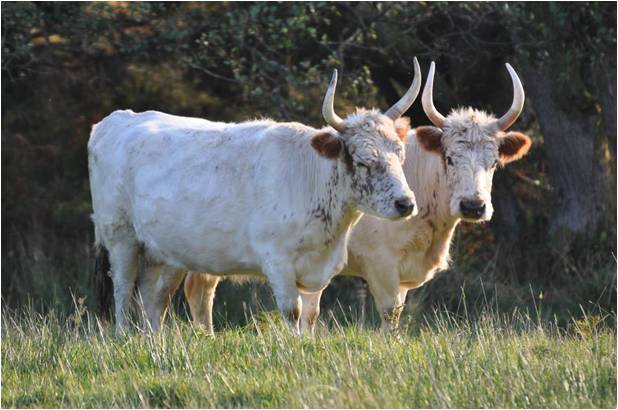Type the name of the breed you're looking for below
[wpdreams_ajaxsearchlite] Don't see the breed your're looking for? Click here and let us know!
Chillingham cattle
| Place of Origin | Great Britain |
| Origin | According to earlier publicity material produced by the Chillingham Wild Cattle Association, Chillingham cattle bear some similarities to the extinct ancestral species Aurochs, Bos primigenius primigenius, based upon cranial geometrics and the positioning of their horns relative to the skull formation. They further claim that Chillingham cattle may be direct descendants of the primordial ox "which roamed these islands before the dawn of history"; moreover, according to Tankerville, these characteristics differed from the cattle brought into England by the Romans. It is now considered much more likely that they are descended from medieval husbanded cattle that were impounded when Chillingham Park was enclosed. But in the absence of adequate genetic or archaeological evidence, these proposed origins must remain purely speculative. However, the traditional view that these cattle have an unbroken line of descent, without intervening domestication, from the wild-living aurochs was already being called into question in the 1800s and is not held by professional opinion, though it is a very attractive concept for the interested public who are not generally conversant with concepts of domestication, taming, or the feral state. Over the years a large popular literature has built up relating to the herd, which has been analyzed in relation to prevalent concepts of ownership and attitudes of people towards big, charismatic animals. Simon Schama described the famous contemporary woodcut by Thomas Bewick as "an image of massive power ... the great, perhaps the greatest icon of British natural history, and one loaded with moral, national and historical sentiment as well as purely zoological fascination". The first written record of the herd dates from 1645 but the Chillingham herd is claimed by some to have been in this site for at least seven centuries. Before the 13th century, this breed is claimed to have "roamed the great forest which extended from the North Sea coast to the Clyde estuary" according to the Countess of Tankerville. During the 13th century, the King of England licensed Chillingham Castle to become "castellated and crenolated" and a drystone wall may well have been built then to enclose the herd. At that time, there was particular concern about Scottish marauders, which explains also the massive build-up of fortification of the nearby Dunstanburgh Castle at the same time. The wall that visitors see at Chillingham was built in the early 19th century to enclose the 1,500 acres (610 ha) of Chillingham Park. As of 2009, the cattle have 330 acres (130 ha) to roam and the rest of the ground is woodland or farmland. |
| Purpose | Feral and are a tourist attraction. |
| Appearance | The Chillingham cattle are related to White Park cattle, in the sense that the Chillingham herd has contributed to the White Park, though there has been no gene flow the other way. Chillingham cattle are small, with upright horns in both males and females. They are white with coloured ears (they may also have some colour on feet, nose and around the eyes). In the case of Chillingham cattle, the ear-colour is red – in most White Park animals the ears are black (which is genetically dominant over red in cattle). Chillingham cattle are of generally primitive conformation while White Parks are of classical British beef conformation. A brief review of academic studies on the Chillingham cattle is available. |
| Horns | Large upright horns. |
| Cows Average Weight | 280 kg (617 lbs.) |
| Bulls Average Weight | 300 kg (661 lbs.) |
| Other Considerations | The Chillingham cattle herd are not tamed in any way, and behave as wild animals. Their behaviour may therefore give some insight into the behaviour of ancestral wild cattle. In the past there has been conflation of the terms "tamed" and "domesticated" and while these cattle are descendants of domesticated animals, there is no handling or taming of individuals. The term "wild" as applied to the Chillingham cattle reflects this conflation but is firmly established historically. They breed all year round and this has clear effects on the detailed structure of their behaviour and bulls occupy and share "home territories" with other members of the herd, and with two or three, or more, other bulls. Home ranges overlap, and are not thought of as defended territories although bulls participate in sparring matches with their home range partners. Studies during winter hay feeding showed that at this time when the cattle were forced into close proximity, cows had a complex social structure apparently based on individual pairwise relationships, while bulls had a linear hierarchy or "peck order". Those studies were made many years ago and the feeding system system now in operation does not bring the cattle into such close proximity. The cattle are extremely vocal with characteristic calls which echo around the area, especially when the bulls are excited by the discovery that a cow is coming into season. Traditionally, the herd has been regarded as having a "king bull" system whereby one bull sires all calves during the period of his "reign" which lasts maybe 2–3 years until he is deposed, usually violently, by a challenger. While this may well have been the case when herd numbers were low, it is less likely to have been in effect when the herd has been numerous. Such a system has been claimed to have retarded inbreeding by preventing a bull from mating with his daughters but such an effect would have been very slight over the 67 generations which is the minimum duration over which inbreeding is likely to have taken place. There is some evidence of testicular hypoplasia which might suggest male subfertility. |



